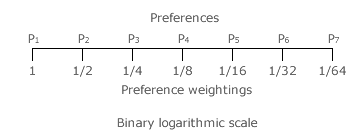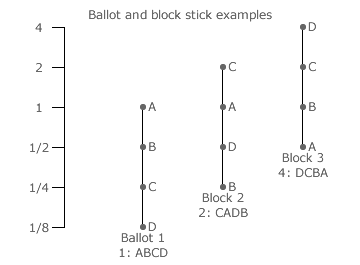Evaluations: Diagrams and Maps 1
Visual Evaluation Tools
With so many variables to consider in multiple-voter multiple-candidate multiple-party multiple-winner GV elections, a separate analysis needs to be undertaken for each unique common ratio. Hence, the evaluations here are restricted to CHPV only. It is already established in the preceding chapters that CHPV has some special features. In terms of its common ratio (r = 1/2) and its teaming index (also r = 1/2), CHPV is the GV variant that is mid-way between its extremes (of r = 0 and r → 1). Its common ratio of one half is also the critical threshold above which voters lose the vital ability to thwart attempts at teaming using cloned candidates. This feature stems from the crucial fact that every CHPV preference weighting is equal to the sum to infinity of all the lower preference weightings. Also, full 100% accuracy for candidate tallies is easily maintained when using CHPV as successively dividing by two only requires one extra decimal place to be added each time. Rounding is never required or permitted.
Multiple-winner elections are generally employed where some degree of party proportionality in the outcome is important. In order to evaluate the performance of CHPV in such elections, two types of visual evaluation tools or figures can be used. Stick diagrams are used to represent voter inputs and both candidate and party performances; especially for critically tied situations. Multiple-winner multiple-party maps can then be drawn where every possible outcome in terms of party tally shares is included, where domain boundaries represent particular critical ties between candidates and where each domain signifies a particular party share of the seats. Remember that these figures are specific to CHPV only; although both figures can easily be adapted to suit any other chosen common ratio.
Stick Diagrams

The name Consecutively Halved Positional Voting (CHPV) concisely describes how its weightings are derived; see opposite. In this illustration, preferences are listed from the first (P1) to the seventh (P7) with its weighting given underneath. As the absolute value of the first preference is irrelevant in any GV election, it is set to one (a = 1) here for convenience. As shown, subsequent CHPV preferences are worth half of the preceding one.
Notice that adjacent preferences are equally spaced along the line; a linear scale where each space represents the common difference of one rank position. However, the weightings do not form a linear scale but form what mathematicians call a binary logarithmic scale; so called because when logs to the base 2 are taken of the weightings, these values then form such a linear scale. [For example, log2(1) = 0, log2(1/2) = -1, log2(1/4) = -2 and log2(1/8) = -3.] Unlike the common difference (of one) between adjacent rank positions, there is a common ratio between adjacent weightings. Ignoring the mathematics, it is the linear spacing of the CHPV weightings when plotted on a binary logarithmic scale that is particularly useful in stick diagrams.
Initially, stick diagrams are introduced and developed below in relation to ranked ballot CHPV elections. When later applied to multiple-winner elections, it then becomes clear that this version of CHPV is unsuited to producing party-proportional results. By adapting this ranked ballot approach into the party-list version of CHPV, stick diagrams then show how a high degree of proportionality between party vote shares and party seat shares may be achieved.

A 'ballot stick' can be plotted alongside a vertical weightings scale (in no particular horizontal position) to display the preferences cast by a voter. In the example opposite, ballot stick 1 represents a voter who ranks the candidates in the order A then B then C and finally D on the single ranked ballot. Where a block of identical ballots are cast, a single 'block stick' can be drawn instead. Block stick 2 represents two voters preferring in turn C, A, D and B and block stick 3 refers to four voters preferring D, C, B and A. Note the shorthand notation for 'quantity of votes: candidate rank order' underneath each stick.
Along each vertical stick, the relevant preference is shown as a dot that horizontally aligns with its appropriate totaled weighting on the scale. Each time the number of voters in a block doubles or halves, the stick is positioned one scale unit higher or lower (respectively) against this scale. It is important to notice that, by specifically using a binary logarithmic scale, only the vertical position of a block stick changes according to the number of voters; not its length nor the relative position of the dots along it.
Proceed to next page > Evaluations: Diagrams & Maps 2
Return to previous page > Evaluations: Introduction (Party-List)
